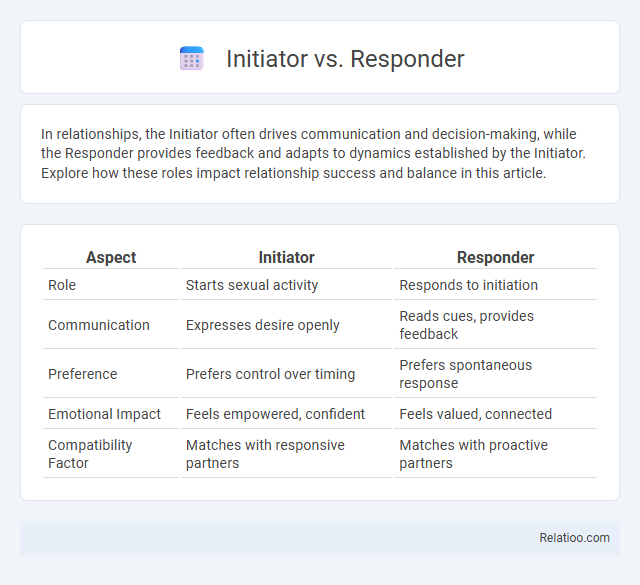In relationships, the Initiator often drives communication and decision-making, while the Responder provides feedback and adapts to dynamics established by the Initiator. Explore how these roles impact relationship success and balance in this article.
Table of Comparison
| Aspect | Initiator | Responder |
|---|---|---|
| Role | Starts sexual activity | Responds to initiation |
| Communication | Expresses desire openly | Reads cues, provides feedback |
| Preference | Prefers control over timing | Prefers spontaneous response |
| Emotional Impact | Feels empowered, confident | Feels valued, connected |
| Compatibility Factor | Matches with responsive partners | Matches with proactive partners |
Introduction to Initiator and Responder Roles
The initiator role involves actively starting interactions or conversations, often driving the pace and direction of communication. The responder role focuses on reacting to the initiator's actions, providing feedback, and maintaining the flow of engagement. Understanding these roles is essential for analyzing communication dynamics, as they define the exchange structure between participants.
Defining the Initiator
The Initiator is the person who actively expresses and pursues their desires or intentions first in a dynamic, often romantic or social interaction. Unlike the Responder, who reacts or answers the Initiator's approach, or someone with Dual desire who both initiates and responds fluidly, the Initiator takes the lead, shaping the direction of the engagement. Understanding your role as the Initiator helps clarify communication patterns and expectations in your relationships and interactions.
Understanding the Responder
Understanding the Responder involves recognizing their role in relationship dynamics where they react to the Initiator's advances rather than initiating themselves. The Responder often prioritizes emotional safety and clear communication, making it essential for you to approach sensitively and attentively. This dynamic contrasts with Dual Desire, where both partners independently initiate and respond, promoting balanced engagement.
Key Differences Between Initiator and Responder
The key differences between Initiator and Responder roles lie in who drives the interaction and decision-making process, with the Initiator taking active control and the Responder reacting or adapting. An Initiator often sets the tone, defines goals, and influences outcomes, while a Responder evaluates and responds accordingly without leading. Understanding your role as either can improve collaboration efficiency and clarify communication dynamics within any interaction.
Importance of Each Role in Communication
The initiator plays a crucial role in starting conversations and setting the tone, which influences the flow and engagement of communication. The responder ensures active listening and provides feedback, enabling effective exchange and understanding between participants. Your ability to balance initiator and responder roles promotes dual desire, fostering mutual interest and enhancing meaningful interaction.
Psychological Traits of Initiators vs Responders
Initiators typically exhibit traits such as assertiveness, confidence, and proactive behavior, driving interactions and decision-making processes. Responders often demonstrate adaptability, receptiveness, and a preference for harmony, valuing cooperation and feedback during exchanges. Understanding your psychological traits as an initiator or responder can help optimize communication strategies and relationship dynamics.
Examples of Initiator and Responder in Daily Situations
The initiator takes the lead in starting conversations or actions, such as suggesting a meeting or proposing a new idea at work, while the responder reacts to these prompts, like answering questions or accepting invitations. For example, in a team project, you may be the initiator by outlining the plan, whereas colleagues respond by providing feedback and completing tasks. Recognizing these roles enhances communication dynamics and helps balance contributions in daily interactions.
Challenges Faced by Initiators and Responders
Initiators often face challenges such as fear of rejection, misreading signals, and managing vulnerability, which can create tension in expressing desire. Responders encounter difficulties in accurately interpreting the initiator's intent while balancing their own readiness and emotional cues. Your ability to navigate these dynamics relies on clear communication and understanding of dual desire, where both partners experience mutual but sometimes asynchronous interest.
Strategies to Balance Initiator and Responder Dynamics
Balancing initiator and responder dynamics requires clear communication of desires and boundaries between partners to prevent misunderstandings and ensure mutual satisfaction. Implementing strategies such as scheduling intimate moments and actively expressing needs helps harmonize differences in sexual desire and responsiveness. Emphasizing empathy and flexibility allows both initiators and responders to feel valued and connected, fostering a healthier relationship dynamic.
Conclusion: Choosing the Right Approach
Choosing the right approach between Initiator, Responder, and Dual desire depends on your communication style and relationship dynamics. Understanding your preferences and those of your partner helps tailor interactions that foster mutual satisfaction and clarity. Your ability to balance assertiveness with receptiveness ensures healthier, more effective exchanges.

Infographic: Initiator vs Responder
 relatioo.com
relatioo.com